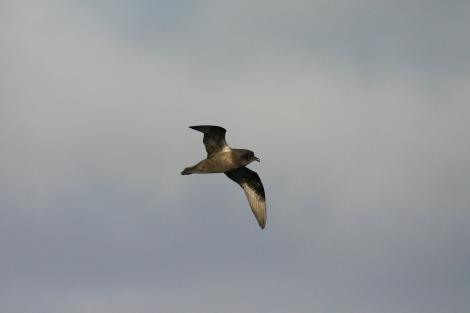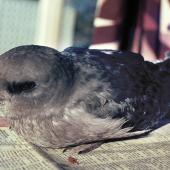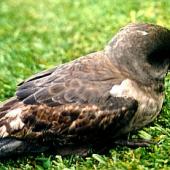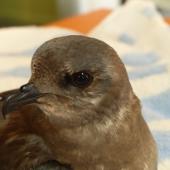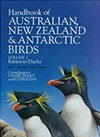Kerguelen petrel
Lugensa brevirostris (Lesson, 1833)
Order: Procellariiformes
Family: Procellariidae
Geographical variation: Nil
The Kerguelen petrel is a small dark ‘gadfly petrel’ that breeds on islands in the southern Atlantic and Indian Oceans. Although rarely seen in New Zealand seas, they are often cast ashore on New Zealand west coast beaches in winter and spring. Kerguelen petrels fly impetuously, towering high above the sea before swooping down to wave level again. It is the only member of the genus Lugensa, and was for many years placed with other gadfly petrels in the genus Pterodroma.
Identification
The Kerguelen petrel is a medium-small, uniformly dark seabird that otherwise resembles a small grey-faced petrel. It is sooty-grey all over, with black bill, and pink-and-black legs and feet. The underwing is uniformly dark, but can reflect low sunlight to appear silvery at the base of the main flight feathers. It appears large-headed and short-necked, with a steep forehead. The bill appears deep and robust in side profile, with prominent nasal tubes and terminal hook. From above, the bill is surprisingly narrow.
Kerguelen petrels are usually solitary at sea, and fly with a distinctive towering flight, using all the air space from wave troughs to 30 metres high. They show little interest in ships, but may fly high over the bow as they pass.
Voice: Kerguelen petrels are silent at sea, and quiet at breeding colonies, where they give a wheezy chee-chee-chay.
Similar species: grey-faced petrel has a similar silhouette, but is larger, longer winged, and the grey face is usually prominent. At close range, the bill of the grey-faced petrel is much larger and more robust.
Distribution and habitat
The Kerguelen petrel is a pelagic seabird of the southern oceans, though less abundant in the Pacific sector. It ranges from the pack ice north to about 33° S. They mainly stay near breeding islands during the southern summer, but immature birds often strand on New Zealand beaches in winter and spring, overlapping with the October laying period. Kerguelen petrels breed on Gough and Inaccessible Islands in the South Atlantic Ocean, and Marion, Prince Edward, Crozet and Kerguelen Islands in the southern Indian Ocean. They nest in colonies, burrowing into flat or gently-sloping tundra or tussock-covered slopes with saturated soils.
Population
The global population of Kerguelen petrels is estimated at 100,000 to 200,000 pairs. Major colonies include Gough, Prince Edward, Marion, Crozet and Kerguelen Islands. They are mainly recorded as beach-wrecked specimens in New Zealand, especially during July-November. Numbers are highly variable each year, with a median of 29 birds, and a range from 1 bird in 1979 to 600 in 1984, when there was a similarly large wreck of blue petrels. Other large wrecks occurred in 1981 (284 birds), 1994 (262) and 1999 (331 birds). Over 200 birds were seen flying near the Open Bay Islands, South Westland, during 8-9 August 1985, yet only 122 were found dead on New Zealand beaches that year.
Threats and conservation
Kerguelen petrels are not globally threatened, but introduced cats and rats are likely to have had severe impacts at some colonies. Feral cats are present on Kerguelen Island and Isle aux Cochons, Crozet Islands, and were present on Marion Island until their eradication in 1991. Ship rats remain present on Isle de la Possession, Crozet Islands The subantarctic skua is the Kerguelen petrel’s main natural predator.
Breeding
The Kerguelen petrel is a colonial, monogamous burrow-nester. Both sexes incubate the single white egg (57 x 45 mm) for 46-51 days, and feed the chick by regurgitation. The chick fledges after 59-62 days. Laying occurs in October, hatching in December, and fledging in late January or early February.
Behaviour and ecology
The Kerguelen petrel is a pelagic seabird, only coming ashore to breed. They are usually solitary at sea, but will indulge in exuberant chases when multiple birds are present. As typical for most small petrels, Kerguelen petrels are nocturnal at their breeding sites, nest in burrows in large colonies, are monogamous, and have shared care of the single egg and chick. Kerguelen show little interest in ships.
Food
Kerguelen petrels mainly eat squid, also crustaceans and small fish, obtained on or near the sea surface by dipping or surface-seizing.
Websites
References
Heather, B.D.; Robertson, H.A. 1996. The field guide to the birds of New Zealand. Viking, Auckland.
Imber, M.J. 1984. The age of Kerguelen petrels found in New Zealand. Notornis 31: 89-91.
Marchant, S.; Higgins, P.J. (eds.), 1990. Handbook of Australian, New Zealand and Antarctic birds. Vol 1, ratites to ducks. Oxford University Press, Melbourne.
Powlesland, R.G. 1986. Seabirds found dead on New Zealand beaches in 1984 and a review of fulmar recoveries since 1960. Notornis 33: 171-184.
Powlesland, R.G. 1987. Seabirds found dead on New Zealand beaches in 1985, and a review of Pterodroma species recoveries since 1960. Notornis 34: 237-252.
Shirihai, H. 2007. A complete guide to Antarctic wildlife: the birds and marine mammals of the Antarctic continent and the Southern Ocean. 2nd edn. A & C Black, London.
Tennyson, A.J.D. 2010. Procellariiformes. Pp 64-135. In: Checklist Committee (OSNZ) 2010. Checklist of the birds of New Zealand, Norfolk and Macquarie Islands, and the Ross Dependency, Antarctica (4th edn). Ornithological Society of New Zealand & Te Papa Press, Wellington.
Recommended citation
Miskelly, C.M. 2013. Kerguelen petrel. In Miskelly, C.M. (ed.) New Zealand Birds Online. www.nzbirdsonline.org.nz
Kerguelen petrel
- Breeding season
-
- Jul
- Aug
- Sep
- Oct
- Nov
- Dec
- Jan
- Feb
- Mar
- Apr
- May
- Jun
- Egg laying dates
-
- Jul
- Aug
- Sep
- Oct
- Nov
- Dec
- Jan
- Feb
- Mar
- Apr
- May
- Jun




